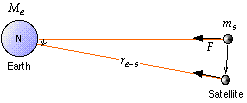Geosynchronous Orbits
One application of the law of gravity is to figure out how to put a satellite into orbit so
that it remains in the same position relative to ground all the time. A satellite in such a
position can be used to relay microwave communication signals from one part of the
globe to another. Such satellites are of major importance in our daily lives, allowing us
to receive hundreds of inane television programs from around the world and to talk to
our dearest relatives on another continent at all too cheap rates. Before communications
satellites, such signals had to be relayed via earth-based relay towers which had to be
placed in sight of one another.
The original idea of geosynchronous communications satellites was published by the
British science fiction writer Arthur C. Clarke in the early 50's. Aldous Huxley
commented that the establishment of such devices would be a global calamity of major
proportions. Now we can judge whether he was right or not.
A good idea
The idea of geosynchronous satellites is to find an orbit over the equator in which the
satellite revolves around the earth at the same rate that the earth spins on its axis. In
other words, find an orbit with a period of 24 hours. Recalling the relationship between
force and period of circular motion, the period, radius and mass of the satellite are
related to the centripetal force pulling the satellite away from a straight path to a
circular orbit. This centripetal force must be supplied by gravity which is also related to
the radius of the orbit. So the trick is to find an orbital radius which works out to give a
period of 24 hours. Can it be done?

To find out, equate the force of gravity at a certain earth-satellite distance to the
centripetal acceleration needed to keep it in orbit with a 24 hour period.

 Find where the gravitational force gives the needed centripetal acceleration:
Find where the gravitational force gives the needed centripetal acceleration:
Fg = Fc

Notice that the mass of the satellite is on both sides of the equation and cancels out. We
know all the other variables: G, mass of earth, and the period. Thus we only have to
solve for the radius of orbit to find out if it is possible, and if so where to put the thing.

![r_{e-s}=\sqrt[3]{G\frac{M_eT^2}{4 \pi^2} }](http://latex.codecogs.com/png.latex?r_{e-s}=\sqrt[3]{G\frac{M_eT^2}{4 \pi^2} })
Thus it is possible! We can solve for r after substituting for G = 0.667 x 10-10
Nm2/kg2, Me= 6x1024 kg and T=24 h x (3600 s/h) = 8.64x104 s.
![r = [ (0 .667 x 6 x 8.64<sup>2</sup>/40) x 10 ^(-10+24+2x4) ]^(1/3)](GeoFig4.GIF)
(You might want to check the units.)
The answer comes out to be 42,300 km. This is the distance measured from the centre of
the earth. It's about 6380 km less when measured from the surface of the earth.